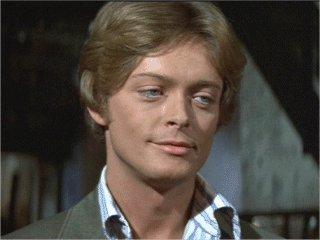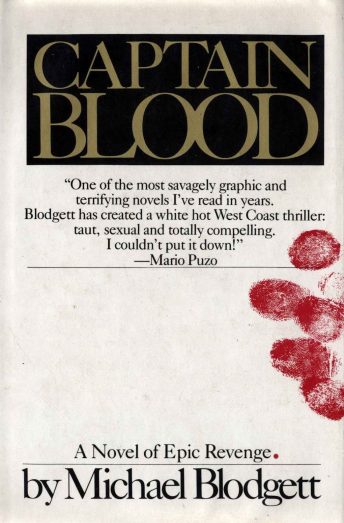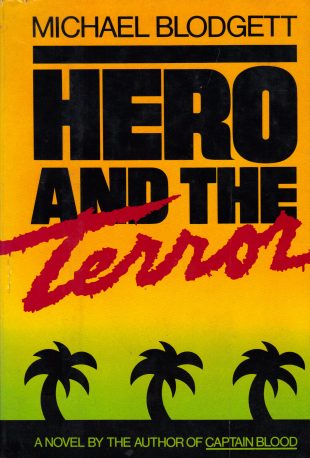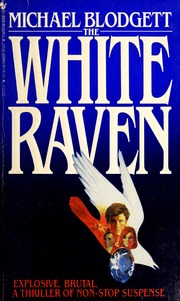 If you know of the late Michael Blodgett (1939-2007) it’s most likely as a beefcake actor in movies like THE VELVET VAMPIRE and BEYOND THE VALLEY OF THE DOLLS, or as the screenwriter of TURNER AND HOOCH and RENT-A-COP, or possibly as a sixties-era talk show host (of the teen beach program GROOVY and the short-lived MICHAEL BLODGETT SHOW). Yet in my view Blodgett’s most enduring work was done in the three unjustly forgotten novels he published in the late seventies and early eighties, one of which is a deranged masterpiece and the other two decidedly not, yet all three books are interesting enough to at least warrant discussion.
If you know of the late Michael Blodgett (1939-2007) it’s most likely as a beefcake actor in movies like THE VELVET VAMPIRE and BEYOND THE VALLEY OF THE DOLLS, or as the screenwriter of TURNER AND HOOCH and RENT-A-COP, or possibly as a sixties-era talk show host (of the teen beach program GROOVY and the short-lived MICHAEL BLODGETT SHOW). Yet in my view Blodgett’s most enduring work was done in the three unjustly forgotten novels he published in the late seventies and early eighties, one of which is a deranged masterpiece and the other two decidedly not, yet all three books are interesting enough to at least warrant discussion.
Those who knew Michael Blodgett tend to describe him as a brilliant, highly charismatic man who was prettier than most women yet had some very real demons. How those demons manifested themselves I don’t know, but his fiction provides some indicators, in particular his debut novel CAPTAIN BLOOD, with its good-looking, near-superhumanly strong and impossibly virtuous Los Angeles dwelling protagonist who’s also a violent sociopath who wears bikini briefs, bangs his own  sister and perpetrates a bloody vigilante killing spree. Further depravities are provided by flashbacks that see our “hero” getting jerked off by his father and witnessing the gruesome slaughter of several black men by Southern rednecks. Just how close Captain Blood was to Michael Blodgett I can’t say, but the character’s violently contradictory nature appears to fit with that of his creator.
sister and perpetrates a bloody vigilante killing spree. Further depravities are provided by flashbacks that see our “hero” getting jerked off by his father and witnessing the gruesome slaughter of several black men by Southern rednecks. Just how close Captain Blood was to Michael Blodgett I can’t say, but the character’s violently contradictory nature appears to fit with that of his creator.
CAPTAIN BLOOD was completed in 1977 but not published until two years later, having reportedly inspired a lot of controversy in the interim. To shock publishers in the 1970s, when “fuck books” were prevalent and minutely described sex and violence were constants in mainstream fiction, was no small feat!
Furthermore, the novel was revised no less than twice, for the 1982 Harmony Books trade paperback and 1985 Bantam Books mass market edition. The version to read, however, is the initial 1979 Stone Hill hardcover, in which all of Blodgett’s minutely described gore, perversion and general ugliness are presented intact. The prose is disarmingly rational throughout, making all the outrageousness seem thoroughly convincing, and even (to borrow a blurb from the back cover) like reasonable conduct. Yet the book’s real fascination is in the way it stubbornly refuses to pin itself down to any single category yet somehow congeals into a satisfying whole, from the unassuming opening, with Captain Blood helping an old lady with a busted iron, to the ultra-bloody final showdown that closes things out on a very dark note indeed.
Following up such an auspicious debut would be a tall order for any writer. It’s no surprise, then, that Blodgett’s second novel HERO AND THE TERROR woefully failed to reach the heights (or perhaps more accurately, depths) of its predecessor.
 The shame is that Blodgett was never much of a storyteller. CAPTAIN BLOOD worked better as a picturesque travelogue than a straightforward narrative, and HERO AND THE TERROR, which appears to have been Blodgett’s attempt at creating a more commercial thriller, is nearly as episodic, with an achingly simple narrative that can be adequately summed up thusly: a vicious serial killer takes up residence in the air ducts of an L.A. movie theater until Hero, a determined cop, discovers the killer’s location and takes him down.
The shame is that Blodgett was never much of a storyteller. CAPTAIN BLOOD worked better as a picturesque travelogue than a straightforward narrative, and HERO AND THE TERROR, which appears to have been Blodgett’s attempt at creating a more commercial thriller, is nearly as episodic, with an achingly simple narrative that can be adequately summed up thusly: a vicious serial killer takes up residence in the air ducts of an L.A. movie theater until Hero, a determined cop, discovers the killer’s location and takes him down.
Said serial killer isn’t in the same league as better-known fictional monsters like Hannibal Lecter or Chaingang Bunkowski, but Blodgett draws a fairly chilling portrait of a high powered attorney with a deteriorating mind who can’t staunch his murderous compulsions. The figure of Hero the determined cop, unfortunately, isn’t nearly as well drawn, he being a narcissistic poetry-spouting jock who, as his moniker signifies, is a tireless crusader for justice who can do no wrong. He’s a bit like Captain Blood—and, one assumes, Michael Blodgett himself—but without the telling contradictions that made Captain so memorable.
But in this book the details are all important. The plot may be flimsy and predictable, but the many gruesome segues are quite arresting. They include Hero’s encounter with an unidentified bum whose entire face has been eaten away, a flashback of the Terror’s father cutting out his hemorrhoids with scissors, a minutely described four page(!) sexcapade between Hero and his girlfriend, and a bleak recounting of the lives of twin sisters whose intertwined existence wavers between extreme hatred and depravity. Truly, a literary imagination as twisted as Michael Blodgett’s is a rare thing, but it needs a stronger framework than that of HERO AND THE TERROR.
THE WHITE RAVEN, from 1985, was the third and sadly last novel by Mr. Blodgett, who proves here that, in contrast to his earlier  novels, he did know how to tell a story. He also once again demonstrates a real talent for the grotesque, as proven early on in this novel when a Jewish woman is subjected to graphically described torture in Nazi Germany.
novels, he did know how to tell a story. He also once again demonstrates a real talent for the grotesque, as proven early on in this novel when a Jewish woman is subjected to graphically described torture in Nazi Germany.
Cut to the present day, when Tully Windsor, yet another of Blodgett’s impossibly sexy Los Angelino protagonists, is basking in the glory of his phenomenally successful writing career. Tully has a definite connection to the preceding events, as does his feeble-minded uncle—who has a small but pivotal role—but that connection isn’t made apparent until near the end.
The action gets underway when, after getting laid by a mysterious young hottie while out jogging one day, Tully is abruptly summoned to Germany. His assignment: to interview the incarcerated Nazi henchman Rudolph Hess about the White Raven, the world’s most flawless diamond. Hess claims to know the White Raven’s location, and during Tully’s interview reveals the apparent combination of the safe where it’s being stored. From there Tully is pursued through Germany, France and the U.S. by the CIA, the Mafia, a band of neo-Nazis and various other creeps, all of whom are anxious to get their hands on the diamond.
Blodgett lays out this action intensive tale in his usual concise manner, and provides at least one spectacularly gruesome surprise (specifically the location of the diamond and how it’s retrieved from said locale). The problem is with the too-good-to-be-true protagonist: when Tully gets into jams there’s never any suspense, seeing as how he’s stronger than everyone else around him, and he’s also blessed with a penis so enormous that upon seeing it for the first time a German babe is so awed all she can say is “Mein Gott!”
Yes, THE WHITE RAVEN has its shortcomings, as do Blodgett’s other novels, but his talent was undeniable. Blodgett’s prose was always arresting and distinct, as was his depiction of a danger-packed, sex-drenched Los Angeles—which, as anyone’s who’s spent any significant amount of time in L.A. will readily acknowledge, isn’t that far from reality.
Tantalizingly enough, Blodgett drafted at least two further books that never saw publication. They include the 1975 horror novella THUMP SQUISH and the 1984 collection THE HOUSE OF CHANG AND OTHER STORIES (whose title story was adapted by Blodgett into an infamous 1992 screenplay about WWII-era mercenaries collecting Nazi scalps—I’m guessing Quentin Tarantino was among the script’s readers). Our chances of ever seeing those books are slim to none, but at least we have CAPTAIN BLOOD, which more than stands on its own, as well as HERO AND THE TERROR and THE WHITE RAVEN, which round it out quite nicely.
